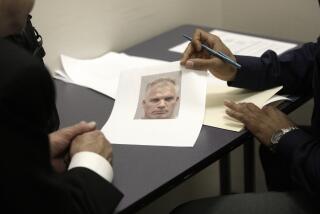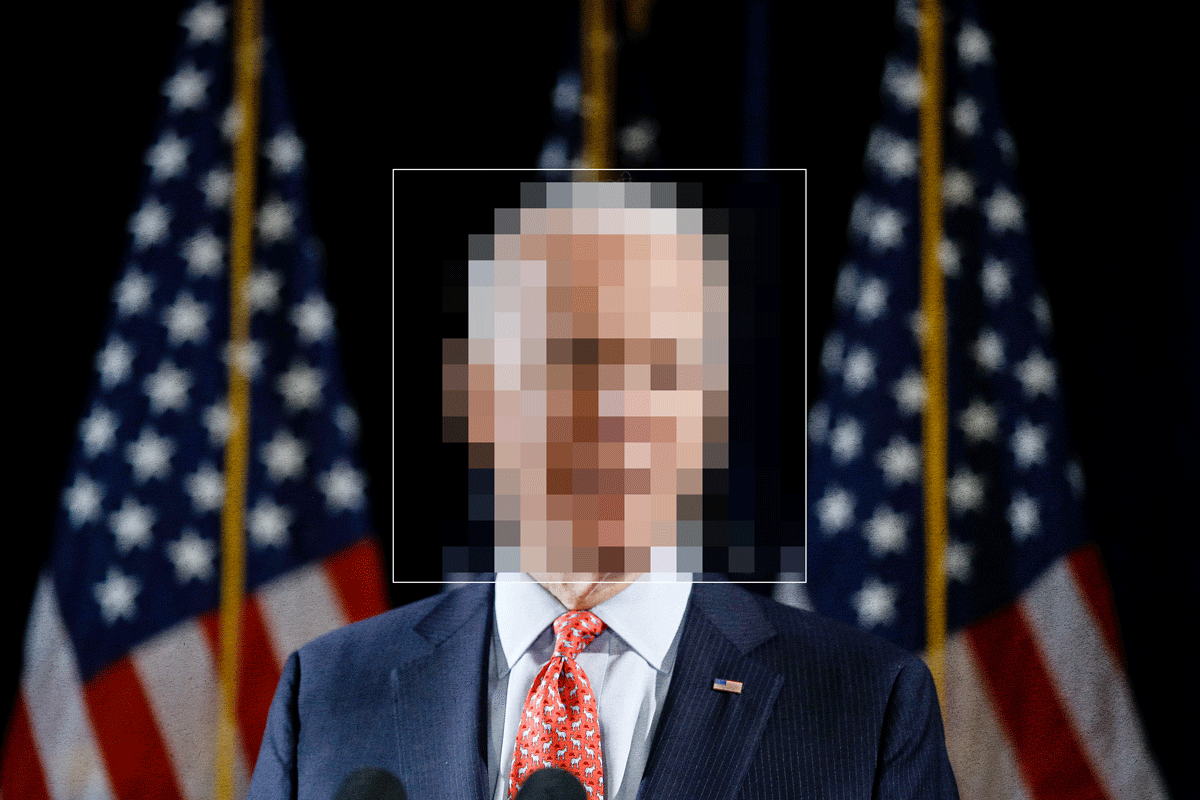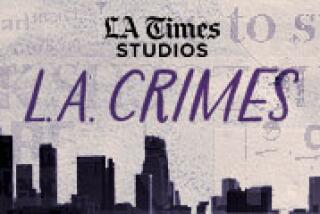Fingerprints’ Accuracy on Trial
- Share via
For nearly a century, fingerprints have been superstars in American courtrooms. If an expert said a fingerprint at the crime scene matched yours, you had some explaining to do. Who could doubt a match?
But today, some legal experts say that may be headed for a change. Within a year, one authority expects, a judge will block fingerprint evidence as unscientific. Another thinks such evidence will still be admitted, but that its credibility will be taken down a notch.
And the author of a book out next month speculates that fingerprint evidence could be eclipsed by DNA identification within a few decades.
What is going on? The Supreme Court recently raised the bar for scientific evidence, and critics say that fingerprinting can’t make the jump.
Fingerprint evidence is based on the idea that no two people have the same fingerprint. But how much confidence should we have in the accuracy of a match between prints carefully taken in a police station and often less-than-perfect prints recovered at crime scenes?
Fingerprint evidence was first admitted to an American court in 1911, and “fingerprints still have a kind of hold on our shared cultural imagination,” said Jennifer Mnookin, a University of Virginia Law School authority on expert evidence. Most people, she said, “think if they found your fingerprints at the scene, that means you were there.”
Judges in the early 20th century accepted fingerprint evidence without much scrutiny, she said. For one thing, it seemed to provide certainty in identifications. Defense attorneys rarely found experts to fight it.
“So fingerprinting wasn’t disputed, and therefore came to be seen as especially authoritative,” Mnookin said.
It “looked like science to judges,” said Simon A. Cole, author of the forthcoming book, “Suspect Identities: A History of Fingerprinting and Criminal Identification” (Harvard University Press).
The popularity continued after a 1923 federal appeals court ruling that said judges should admit scientific evidence if it’s based on a technique generally accepted by the relevant scientific community.
But in 1993, a Supreme Court decision required judges to take a more active role in deciding what scientific evidence to admit. In the case of fingerprints, the so-called “Daubert” guidelines would lead to questions such as: Has the practice of fingerprint identification been adequately tested? What’s the error rate? Are there standards and controls?
Under these criteria, critics say, fingerprint identification could be challenged on the grounds that it has not been adequately tested, that the error rate has not been calculated, and that there are no standards for what constitutes a match.
For example, critics say it’s not clear how many matching points of comparison, such as a ridge splitting into two or the contours of individual ridges, are sufficient for an examiner to make an identification.
The Daubert guidelines cover federal courts, and other courts in half of the states have decided to follow that approach. So any ruling against fingerprint evidence could affect courts across the country.
The first challenge to fingerprint evidence under the Daubert guidelines was played out at a federal court hearing in July 1999 in Philadelphia, before the trial of a man accused of driving a getaway car in a robbery. The prosecution said the man’s prints were on the gearshift and door of the car. In the end, the judge allowed the fingerprint evidence in the trial, and the man was convicted.
At least 10 other such challenges have been filed since, but none has yet kept fingerprints out of a trial.
That shows judges have recognized fingerprint evidence as meeting Daubert criteria, said Stephen Meagher, unit chief for latent print work at the Federal Bureau of Investigation laboratory.
“The fingerprint discipline has 100 years of history,” Meagher said. “There is extensive documentation to the scientific basis, which has been published, peer-reviewed and challenged many times. . . . It has withstood those challenges.”
A year ago, in an announcement seized on by critics of fingerprinting, the Justice Department’s National Institute of Justice said it was ready to spend $500,000 for studies of the discipline.
It said the field needed more evidence for the idea that fingerprint analysis really can link a print to only the person who made it, and that the field needed standardized analysis procedures that are shown to work with acceptable error rates.
Last June, however, the institute issued a clarification, declaring that it has no reason to doubt that fingerprints are unique. It said the announcement sought studies only “to further confirm the already existing basis that permits fingerprints to be used” for identification.
Citing “the success of current procedures,” the institute said fingerprint analysis should still be periodically studied to improve its experimental backing.
The institute is looking over four proposals to do the research, and it’s not yet clear whether it will accept any of them, institute spokesman Doug Johnson said.
So what happens now with fingerprint evidence? Should it continue to be admitted into court?
“I think you can make good arguments on both sides of that one,” Mnookin said. But if it’s admitted, she added, judges should also allow it to be challenged by defense experts critical of fingerprint evidence.
In fact, that has happened in some recent cases, and that itself is a major victory for the defense, said Robert Epstein, an attorney in Philadelphia’s federal public defender’s office. “That shows judges are recognizing the legitimacy of this issue,” said Epstein, who filed the first Daubert challenge to fingerprints.
Others expect a successful challenge soon.
“I would predict . . . that within the next year, if not within the next six months, some judge somewhere in the country will write an opinion excluding fingerprinting,” said professor David Faigman of UC’s Hastings College of Law in San Francisco. “It’s inevitable. The research is just too thin to let it in.”
Not that Faigman thinks fingerprint evidence is bunk. “My common sense tells me at some level, fingerprinting will be very valid, and it will continue to be an incredibly good forensic tool,” he said.
But so far, he said, “no judge has been courageous enough to stand up and do what Daubert absolutely demands, and that is to exclude fingerprinting until the research is done.”
Edward Imwinkelreid, a law professor at UC Davis and co-author of a text on scientific evidence, said he’d be surprised if that happened in the foreseeable future. He does expect that gradually, over maybe a decade, judges will continue to admit the evidence but begin to handle it differently.
Fingerprints “may not be treated as full-fledged scientific evidence,” he said. Instead, judges may tell jurors that identifications are based on the experience of fingerprint examiners, and that jurors should consider that in deciding how much weight to give to fingerprint testimony.
If a defense attorney exploits that jury instruction, he said, it sometimes could make a difference in the verdict.
Cole, the author, speculates that eventually--maybe over 30 years --fingerprints will be replaced by DNA for identification. He noted that fingerprinting itself had replaced a popular method of criminal identification that was based on bodily measurements and careful physical description.
At first, that older system “seemed much more scientific than fingerprinting,” he said. “Then, gradually, our opinion of what was scientific shifted. It seems to me we might be in the middle of another such shift.”
“We’re clearly living in the genetic age,” he said. “I think a time will come when people will feel more comfortable with saying identifications are based on DNA rather than fingerprinting. Fingerprinting will look antiquated to us.”
At a crime scene, DNA can be recovered from more than just blood or semen. It can be lifted from objects handled by people, for example. Florida police recently arrested a murder suspect after he spat in a parking lot and police recovered DNA from his saliva. Another source from which DNA has been recovered: the fingerprint.
But FBI fingerprint expert Meagher, noting that identical twins have identical DNA but different fingerprints, doubts genetic material will completely replace the intricate ridges on skin.
Rather, he says, “we will continue to take advantage of both of them.”
*
onin.com/fp/daubert--links.html describes recent legal challenges to fingerprinting.
More to Read
Sign up for Essential California
The most important California stories and recommendations in your inbox every morning.
You may occasionally receive promotional content from the Los Angeles Times.













